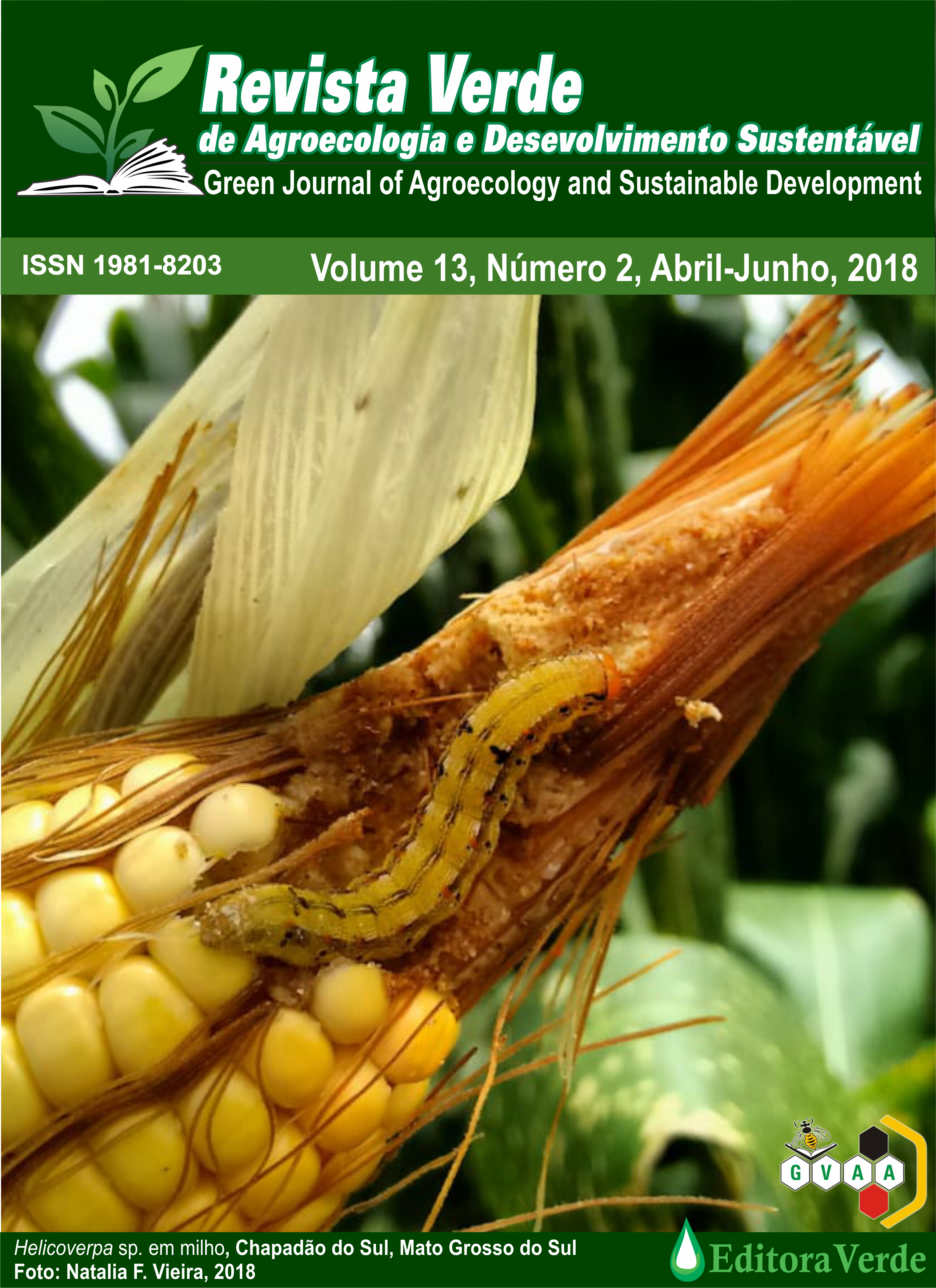Drying temperature of the onion skin for making tea
DOI:
https://doi.org/10.18378/rvads.v13i2.5281Keywords:
Allium cepa L., Phenolic compounds, InfusionAbstract
The objective of this work was to perform the reuse of the onion residue, specifically the bark, to obtain the powder through the convective drying process, analyzing the physical parameters for later application as tea. The powders and teas were submitted to the physical, chemical and physico-chemical characterization. In the statistical treatment, the experimental design of completely randomized blocks with 4 treatments and 3 replicates was used, the data were submitted to analysis of variance and the means comparison was done by the Tukey test at 5% probability. The onion peel has a higher acid content in pyruvic acid than the dry (powder) samples. The onion peels have a clear luminosity, as does tea at both temperatures, noting that it did not change this parameter in the two forms (bark and tea). The temperature interfered satisfactorily in the bark for the flavonoid values; in contrast, the anthocyanins, chlorophylls and carotenoids values were unsatisfactory; for the teas, it was observed that the values of flavonoids, carotenoids, chlorophyll and anthocyanins decreased and presented a change in the values with the change in temperature. Therefore, it can be concluded that the use of different drying temperatures becomes impracticable, and the preparation of the tea with the bark in natura provides the highest levels of the components.Downloads
References
ALBISHI, T.; JOHN, J. A.; AL-KHALIFA, A. S.; SHAHIDI, F. Antioxidative phenolic constituents of skins of onion varieties and their activities. Journal of functional foods. v. 5, p. 1991-1203, 2013.
BISPO, R. C.; QUEIROZ, S. O. P.; OLIVEIRA, G. M.; CARVALHO, A. R. P.; FLORES, D. S. “Desempenho agronômico de cultivares de cebola sob diferentes tensões de água no solo.” Irriga, v. 22, n. 3, p. 485-496.
BOBBIO, P. A.; BOBBIO, F. O. Pigmentos naturais. In: BOBBIO, P. A.; BOBBIO, F. O.(Ed.) Introdução à Química de Alimentos. 2ª ed., São Paulo: Varela, 1995. cap.6, p.191-223.
CHITARRA, M. I. F.; CHITARRA, A. B. Pós-colheita de frutos e hortaliças: fisiologia e manuseio. Lavras: ESAL/FAEPE, p. 293, 1990.
FRANCIS, F. J. Analysis of anthocyanins. In MARKAKIS, P. Anthocyanins as Food Colors. New York, pp. 182-205, 1982.
GALO, G. T.; LIMA, A. C. S.; MACHADO, K. M.; VIEIRA, L. B.; MARTINS, V. C.; FERREIRA, N. L.; LUCARINI, A. C.”Estudo da extração da quercetina a partir da cebola roxa (Allium ceppa L.) e seu uso como conservante alimentar natural.” The Journal of Engineering and Exact Sciences, v. 4, n., p 0153-0162, 2018.
INSTITUTO ADOLFO LUTZ, IAL. Normas Analíticas do Instituto Adolfo Lutz: métodos físicos e químicos para análise de alimentos. Digital. I.A.L., 4.ed, 1.ed., São Paulo, 2008.
IBGE. Indicadores IBGE 2013. Disponível em: <ftp://ftp.ibge.gov.br/Producao_Agricola/Fasciculo_Indicadores_IBGE/2013/estProdAgr_201309.pdf >.Acesso em: 02 set 2015.
KANG, S., KIM, Y., HYUN, K., KIM, Y., SONG, B., SHIN, S., PARK, Y. Development of separating techniques on quercetin-related substances in onion (Allium cepa L.). 1. Contents and stability of quercetin-related substances in onion. Journal of the Korean Society of Food Science and Nutrition. v. 27, pp. 682–686, 1998.
KO, M. J.; CHEIGH, C. I.; CHO, S. W.; CHUNG, M. S. Subcritical water extraction of flavonol quercetin from onion skin. Journal of Food Engineering. v. 102, pp. 327-333, 2011.
LICHTENTHALER, H. K. Chorophylls and carotenoids: pigment photosynthetic biomembranes. Methods enzymol., San Diego, v. 148, pp. 362-385, 1987.
LIMA, V. L. A. G; MÉLO, E. A.; LIMA, L. S.; LIMA, D. E. S. Polpa congelada de acerola: efeito da temperatura sobre os teores de antocianinas e flavonóis totais. Rev. Bras. Frutic., Jaboticabal - SP, v. 24, n. 3, p. 669-670, dez. 2002.
MALDONADO-ROBLEDO, G.; RODRIGUEZ-BUSTAMANTE, E.; SANCHEZ-CONTRERAS, A.; RODRIGUEZ-SONOJA, R.; SANCHEZ, S.; Production of tobacco aroma from lutein. Specific role of the microorganisms involved in the process. Applied Microbiology e Biotechnology, v. 62, pp. 484-488, 2003.
MORETTI, C.L; DURIGAN, J.F. Processamento de cebola. Informe Agropecuário, v.23, n. 218, pp. 99-104, 2002.
NASCIMENTO, V. R. G.; BIAGI J.; OLIVEIRA, R. A. ”Modelagem matemática da secagem convectiva com radiação infravermelha de grãos de Moringa oleífera”. Revista Brasileira Engenharia Agrícola Ambiental, v. 19, n. 7, p. 686-692, 2016.
OLIVEIRA, R. A.; SOUZA, M.; KUTZ, C.; BRUNETTO, G.; COMIN, J. J. “Produção de matéria seca de plantas de cobertura de inverno e rendimento de cebola ao longo de cinco anos sob Sistema de Plantio Direto Agroecológico.” Caderno de Agroecologia, v. 10, n.3, 2016.
PADILHA, M. D. R. F; SHINOHAAR N. K. S.; OLIVEIRA, F. H. P. C.; SILVA, S. M.; MATSUMOTO, M. “Alimentos elaborados com partes não convencionais: avaliação do conhecimento da comunidade a respeito do assunto. ” Anais de Academia Pernambucana de Ciência Agronômica, v. 11, p.216-225, 2016.
SILVA, F. A. S.; AZEVEDO, C. A. V. The Assistat Software Version 7.7 and its use in the analysis of experimental data. Afr. J. Agric. Res, v.11, n.39, p.3733-3740, 2016.
SIQUEIRA, M. P.; Composição química e atividade biológica de resíduos agroindustriais. Dissertação de mestrado. Universidade de São Paulo. 2010.
SCHIMITT, R. D. Cebola. Síntese Anual da Agricultura de Santa Catarina – 2010-2011. Disponível em: <http://cepa.epagri.sc.gov.br/Publicacoes/Sintese_2011/Cebola%20sintese%202011.pdf>. Acesso em: 02/09/2015.
SCHUNEMANN, A. P.; TREPTOW, R.; LEITE, D. L.; VENDRUSCOLO, J. L. Pungência e características químicas em bulbos de genótipos de cebola (Allium cepa L.) cultivados no alto Vale do Itajaí, SC, Brasil. R. Bras. Agrociência, Pelotas, v. 12, n. 1, pp. 77-80, jan-mar, 2006.
SOARES, V. L.; FINGER, F. L.; MOSQUIM, P. R. Influência do Genótipo e do Estádio de Maturação na Colheita sobre a Matéria Fresca, Qualidade e Cura dos Bulbos de Cebola. Horticultura Brasileira, Brasília, v. 22, n. 1, pp. 18-22, 2004.
VILHALVA, D. A. A.; JÚNIOR, M. S. S.; CALIARI, M.; SILVA, F. A. Secagem convencional de casca de mandioca proveniente de resíduos de indústria de amido. Pesq. Agropec. Trop., Goiânia, v. 42, n. 3, pp. 331-339, jul/set 2012.
WOISKY, R.; SALATINO, A. Analysis of propolis: some parameters and procedures for chemical quality control. J. Apic. Res. v. 37, pp. 99-105, 1998.











